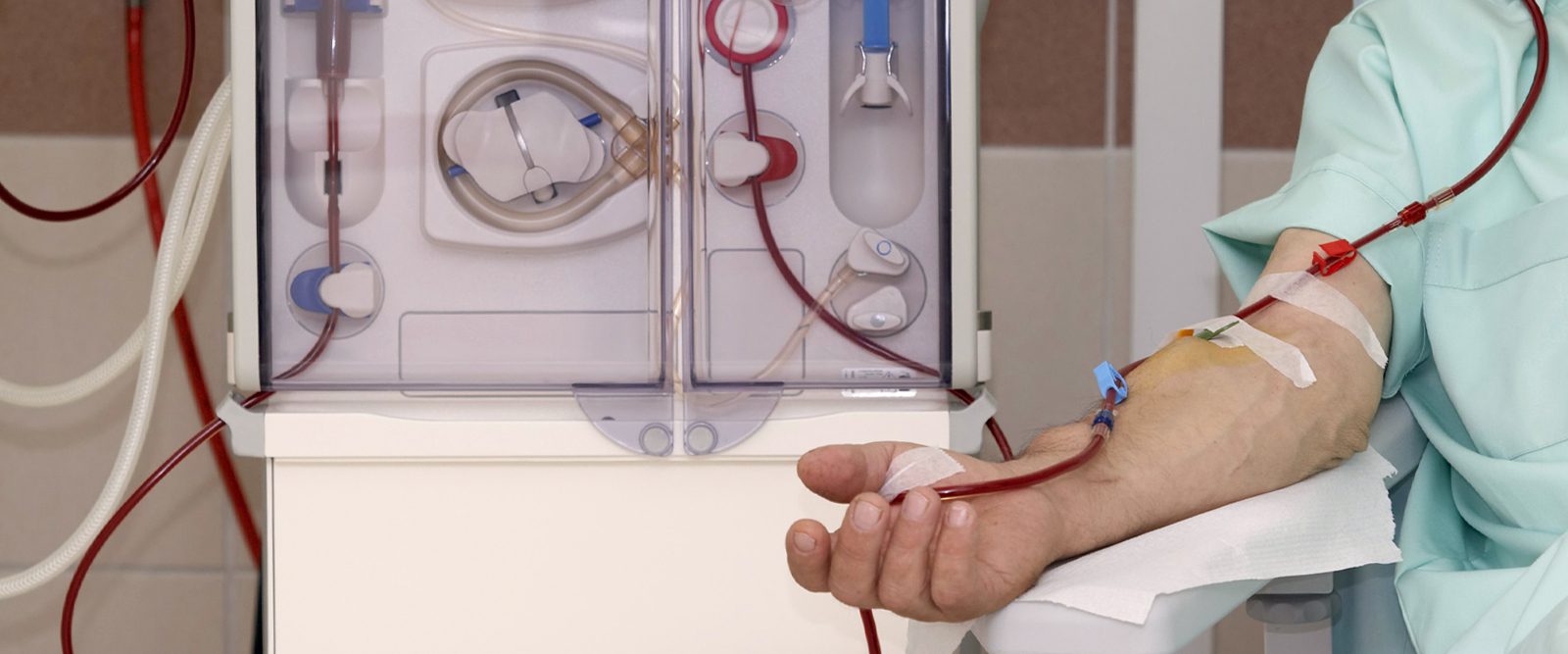How Does Dialysis Work?
With chronic kidney disease rates on the rise and more patients needing dialysis, a nephrologist explains how the treatment works and the different options available to patients.

Kidneys play a vital role in our bodies by filtering toxins and removing excess fluid from our blood. Unfortunately, an increasing number of Americans are struggling with kidney disease. According to the Centers for Disease Control and Prevention, about 15% of Americans have chronic kidney disease, with many undiagnosed. Additionally, nearly 800,000 people are in kidney failure — the end stage of kidney disease, when it has progressed to the point where kidney function is so diminished that waste and fluid build up in the bloodstream. The treatment options for kidney failure are a kidney transplant or — more commonly — dialysis.
“Dialysis is a procedure that uses a specialized machine that essentially takes the place of your kidneys when they can no longer function,” says Dr. Sean Kalloo, a nephrologist at NewYork-Presbyterian/Columbia University Irving Medical Center. “It basically removes blood from the body, filters it to remove toxins, balances certain electrolytes, and returns the blood cleansed.”

Dr. Sean Kalloo
While most dialysis treatments take place in dialysis centers, there are now more options available, including the ability to undergo dialysis at home. “We strive to offer patients different options, but it requires preparation and guidance,” says Dr. Kalloo.
Health Matters spoke to Dr. Kalloo about the different types of dialysis, what to expect from treatment, and what NewYork-Presbyterian is doing to address disparities in chronic kidney disease and kidney failure.
When is dialysis necessary?
Dr. Kalloo: As kidneys begin to fail, toxins build up in the blood, which can cause symptoms such as nausea, vomiting, decreased appetite, extreme fatigue, widespread itching, and confusion. These are called uremic symptoms, and dialysis becomes necessary when symptoms persist, and eventually the kidneys stop working. Kidney failure can also impact the function of vital organs such as the heart and lungs, leading to congestive heart failure and pulmonary edema.
What are the different types of dialysis?
We’ve made significant strides in treating patients with kidney failure, and that includes providing options for them. Dialysis can be demanding due to the frequency of treatments, but it’s important to remember that advancements in care have made the process more manageable, offering patients hope and improved quality of life.
- In-center hemodialysis
Schedule: Three appointments a week at a dialysis center. Each treatment lasts at least three hours.
How it works: First, nurses and technicians need access to the blood to remove it and put clean blood back into the body. There are three ways to do the procedure — a fistula (a surgery that connects an artery and vein); a graft (essentially a plastic tube connecting an artery and a vein under the skin); or a tunneled dialysis catheter (a soft, plastic tube inserted into a vein in the neck). About 80% of patients in the U.S. start with a catheter, but it’s not ideal due to the increased risk of infection. The center has the necessary equipment and handles the treatment process, but patients have to travel several times a week. - Home hemodialysis
Schedule: At home, four or five days a week. The timing is flexible depending on work, school, or other commitments. Each treatment lasts 2½ to three hours.
How it works: After a series of training sessions, patients can administer dialysis themselves or with the help of a caregiver at home. Patients require a fistula or graft, as with in-center hemodialysis. In addition to allowing for more flexibility, home dialysis is gentler on the body, and helps to minimize fatigue following treatments. - Peritoneal dialysis
Schedule: At home, nightly, during the day, or a combination of the two. It takes an average of eight or nine hours, so it is commonly performed when patients are sleeping.
How it works: This process does not involve blood at all. Instead, a catheter is inserted into the peritoneal cavity, which is the space created from the lining of internal organs in the abdominal cavity. A dialysis machine called a cycler pumps specialized fluid into the peritoneal space, extracts the toxins, and drains the fluid out.
Do you recommend one type of dialysis over another?
It’s ultimately the patient’s decision. For example, some patients may wish to continue working or going to school, or they may have children to care for, and they don’t have time to go to a center several times a week. We can then discuss the option of doing dialysis at home. Others may say, “I don’t have the space and don’t want the responsibility, so I prefer to do it in a dialysis center.”
To make an informed decision, planning ahead is essential. Given the progressive nature of kidney disease, patients can collaborate with their providers to develop a plan. Ideally, we aim to prevent urgent situations in which patients may end up at the emergency room due to acute kidney failure. In those cases, patients may be required to start dialysis immediately, which limits their ability to make choices.
Are there side effects?
Due to the significant volume of fluid that may be removed during dialysis, patients may experience symptoms such as low blood pressure, fatigue, or cramping. Following treatment, it can take patients a day or so to recover. Side effects like these are more likely to occur with in-center hemodialysis and are less frequent with both home hemodialysis and peritoneal dialysis.
What are the risks associated with dialysis?
There are risks, and we try to mitigate them by performing the treatment in a coordinated and controlled manner, paying particular attention to avoiding infections. Despite this, infections can occur — particularly in patients with a tunneled dialysis catheter. Low blood pressure is also a concern during treatments because of the fluid removal. In rare cases, patients experience a syndrome called dialysis disequilibrium, which causes them to feel dizzy and confused during the treatment because the body is not used to a machine cleaning the blood. While there are risks associated with dialysis, the risk of untreated kidney failure can be even greater, underscoring the importance of timely intervention and proactive management strategies.
Diabetes and hypertension are the most common causes of chronic kidney disease. What advice do you have for patients with these conditions?
Patients who have diabetes and/or high blood pressure should have at least one annual medical check-up that includes an assessment of their kidney function.
When patients develop diabetes or hypertension, they are understandably focused on the health issues associated directly with those diseases. But as time goes on, these conditions can damage the kidneys. As a result, patients with advanced disease may start to experience symptoms like foamy or bubbly urine due to an elevated concentration of protein in the urine; anemia, leading to fatigue; nausea; poor appetite; and an increased risk of fractures. To some extent, kidney disease is silent because the damage is usually progressive. The only way to know if you have chronic kidney disease is to screen for it with blood and urine tests.
What are ways you can prevent kidney failure and avoid needing dialysis?
Ideally, our goal is to provide care to patients at an earlier stage in the disease course. Many patients see a nephrologist when they are already at stage 3 of chronic kidney disease. If we can control kidney decline early on, there is a better chance of that patient not requiring dialysis and getting evaluated earlier for a kidney transplant. We call this a “preemptive transplant.” If we can achieve that, then we’ve truly changed the patient’s life expectancy and overall quality of life.
Addressing Kidney Health Disparities
Kidney disease disproportionately impacts Black Americans, who are nearly 4 times more likely than white Americans to experience kidney failure. And though they represent only 13.5% of the U.S. population, more than 35% of dialysis patients are Black.
In 2015, The Rogosin Institute, an affiliate member of NewYork-Presbyterian, launched an innovative program called Prevention and Education in Advanced Kidney Disease (PEAK) to address chronic kidney disease and kidney failure. Patients enrolled in PEAK get a team consisting of physicians, nurse educators, social workers, dietitians, and peer mentors. Family and caregivers are also involved every step of the way. The goal is to reach patients early in the disease and provide the education and support they need. In doing so, the program can help patients decide how they want to do dialysis — including training them at home — and can help get them on a transplant list before they experience kidney failure.
Last year, NewYork-Presbyterian’s Dalio Center for Health Justice gave the Rogosin Institute funding to expand PEAK to NewYork-Presbyterian/Columbia University Irving Medical Center. “It is important to note that with Black and Latino patients, there are major disparities with regard to access to transplantation, home dialysis modalities, and general chronic kidney disease management,” says Dr. Kalloo. “PEAK allows us to level the playing field in an attempt to correct these disparities and help these patients navigate chronic kidney disease, which can be confusing and often overwhelming.”
Additional Resources
Get more info about NewYork-Presbyterian’s nephrology services, including the Prevention and Education in Advanced Kidney Disease (PEAK) program.
Learn about the NewYork-Presbyterian Dalio Center for Health Justice.
Sign up to become an organ donor.
